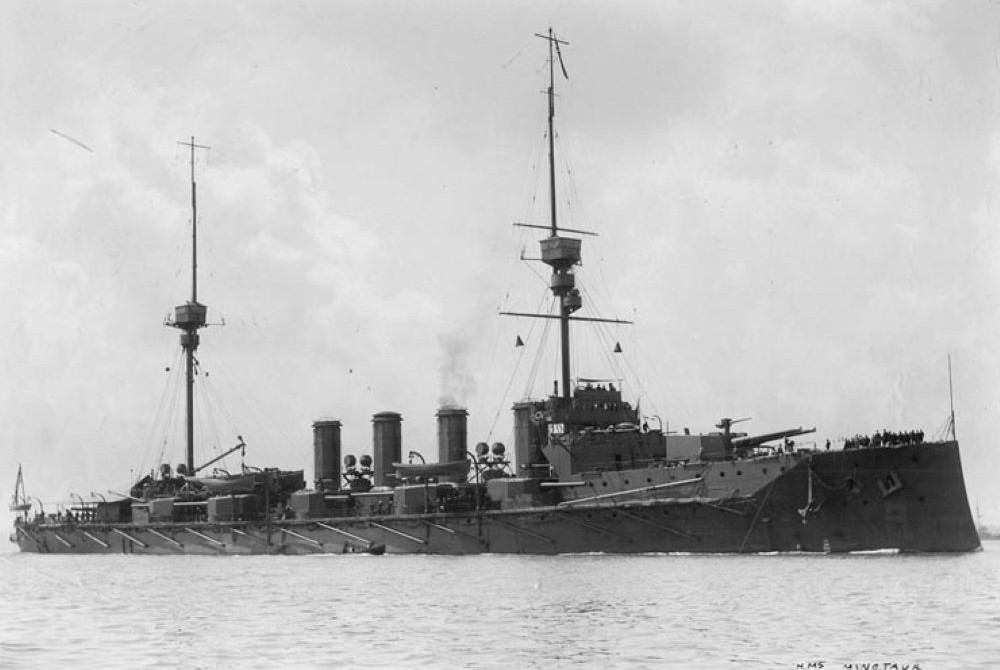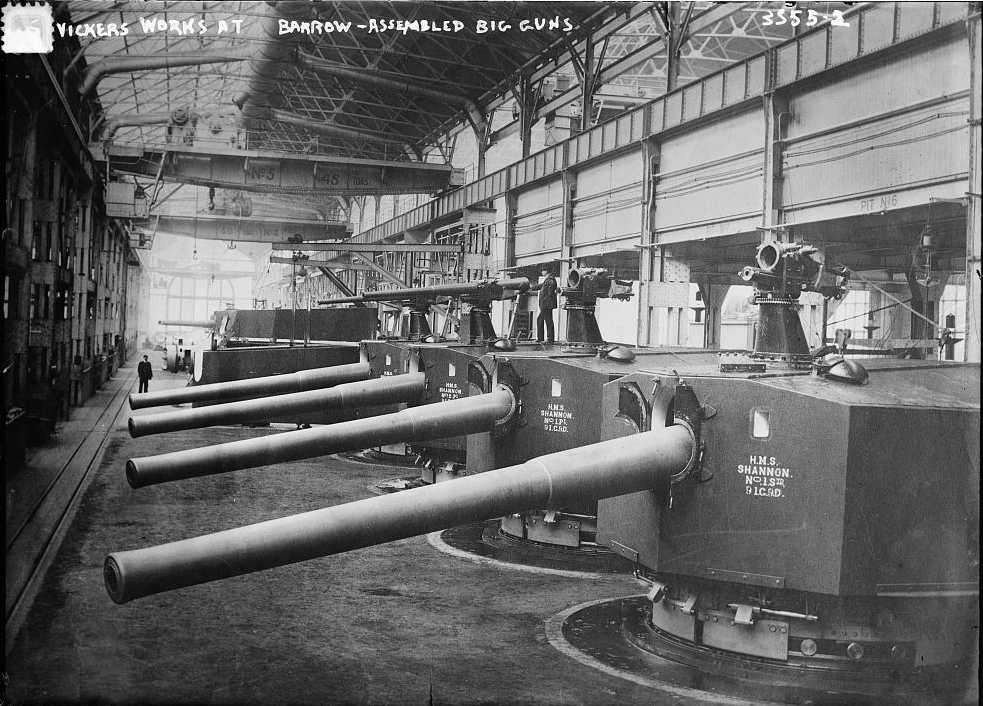

Similar in construction to the Mark I**, but with a "pure-couple" breech mechanism. The original Mark II gun was a Vickers design which was intended for use in coastal defense batteries located in India for use against Russian cruisers. Twenty-two of these guns and the similar Mark II* were ordered expressly for that purpose. However, the disastrous results of the Russo-Japanese War greatly reduced the perceived threat and the order was reduced to 19 guns of which only eight guns were actually used in coastal batteries. Five of the remainder were transferred to the Royal Navy but never used.
The Mark II** and Mark V were modified designs intended from the start as naval guns. Mark II** guns were made by Woolwich, Elswick and Vickers, with slight differences between the various manufacturers. Only Vickers made the Mark V gun. These naval guns were used as secondaries on the last British armored cruisers.
Extracts from Admiral E.C. Troubridge's court-martial (for letting Goeben get away in 1914) regarding these guns include this comment: "For the 9.2-inch Mark X and XI and 7.5-inch Mark II the average spread [dispersion] was 200 - 250 yards at a range of 7000 - 8000 yards."
Some additional details for these guns from the June 1914 battle practice for Defence and Warrior; no speeds or courses of the firing ship or target are given: At just under 8,000 yards (7,300 m), Defence scored 5 direct hits and 1 ricochet with her 9.2" (23.4 cm) guns and 8 hits and 1 ricochet from her 7.5" (19 cm) guns. Defence fired 29 rounds from her 9.2" (23.4 cm) guns and 62 rounds from her 7.5" (19 cm) guns in 6 minutes. Her director firing system broke down during the practice preventing more hits being made. At the same range, Warrior scored 7 hits and 5 ricochets from her 9.2" (23.4 cm) guns and 2 hits and 4 ricochets from her 7.5" (19 cm) guns. Warrior fired 40 rounds from her 9.2" (23.4 cm) guns and 19 rounds from her 7.5" (19 cm) guns in 4 minutes 15 seconds.
In late June 1918 six guns were offered to the Army for relining to high-velocity AAA weapons, but this offer was declined.
Mark II was constructed of A tube, breech ring screwed to the jacket and a "pure couple" breech mechanism. Mark II* differed only in a thicker 'A' tube over the breech bush, the Mark II** was a navalized version. There were different versions of the Mark II**, as two guns were to a Woolwich design, eight to a slightly different Elswick design and six to a Vickers design. Mainly, the Mark II** differed from the Mark II* in that it had generally thicker A tube with correspondingly less wire, a thicker inner A tube in some units and the rear end of the jacket was reinforced by a screwed or shrunk on C hoop immediately in front of the breech ring. The Mark V was like the Mark II** but there was no 'C' hoop. "Steel choke" was a problem and many guns had cannelured rings as a corrective measure.
Of the naval guns, besides the five transferred Mark II guns, 16 Mark II** and 40 Mark V were manufactured. By 1939, a total of 25 of these guns remained, four Mark II, one Mark II** and 20 Mark V. These had been retained for possible use in monitors, but the mountings had been scrapped in 1938-39, making it impossible to use the guns. For that reason, most of these guns were scrapped in 1943-44, although four were retained for experimental purposes.
Two guns were made for Canada prior to World War I and were known as Vickers Mark C. These guns only differed in rifling details from the Mark V.
| Designation | 7.5"/50 (19 cm) Mark II
7.5"/50 (19 cm) Mark V |
|---|---|
| Ship Class Used On | Warrior, Minotaur and Achilles classes |
| Date Of Design | about 1905 |
| Date In Service | 1908 |
| Gun Weight | Mark II: 14.56 tons (14.8 mt)
Mark V: 15.06 tons (15.3 mt) |
| Gun Length oa | 386.7 in (9.822 m) |
| Bore Length | about 375.0 in (9.525 m) |
| Rifling Length | N/A |
| Grooves | N/A |
| Lands | N/A |
| Twist | N/A |
| Chamber Volume | N/A |
| Rate Of Fire | 4 rounds per minute |
| Type | Bag |
|---|---|
| Projectile Types and Weights 1 | AP: 200 lbs. (90.7 kg)
Common: 200 lbs. (90.7 kg) CPC: 200 lbs. (90.7 kg) HE: 200 lbs. (90.7 kg) |
| Bursting Charge | N/A |
| Projectile Length | N/A |
| Propellant Charge | 61.0 lbs. (27.7 kg) 26 Cordite MD |
| Muzzle Velocity | 2,827 fps (862 mps) |
| Working Pressure | N/A |
| Approximate Barrel Life | 650 rounds |
| Ammunition stowage per gun | 100 rounds |
- ^Shells were mainly 2crh, but 4crh was later issued to the Minotaur class.
| Elevation | CRH | Distance |
|---|---|---|
| 15 degrees | 2 | 14,328 yards (13,100 m) |
| 4 | 15,571 yards (14,240 m) |
- ^Taken from range tables, but "British Naval Guns 1880-1945 No 9" says that the 2crh figures were probably about 200 yards (180 m) too far.
| Range | Danger space |
|---|---|
| 8,000 yards (7,300 m) | 75 yards (69 m) |
| 12,000 yards (10,970 m) | 30 yards (27 m) |
| 16,000 yards (14,630 m) | 0 yards (0 m) |
| Range | KC Side Armor |
|---|---|
| 3,000 yards (2,740 m) | 4.5 in (11.4 cm) |
- ^Data from "The Grand Fleet: Warship Design and Development 1906-1922" for an angle of obliquity of 30 degrees and a striking velocity of 1,683 fps (513 mps). Projectiles were salt-filled (blind).
| Designation | Single Mounts
Warrior (4), Minotaur (10) and Achilles (4): CP Mark III |
|---|---|
| Weight | 98 tons (99.6 mt) |
| Elevation | -7.5 / +15 degrees |
| Elevation Rate | Manual operation, only |
| Train | about +150 / -150 degrees |
| Train Rate | N/A |
| Gun recoil | N/A |
| Loading Angle | N/A |
The Vickers Photographic Archive
See photographs 4890,
6464
and 6486
"Warrior to Dreadnought: Warship Development 1860-1905" and "The Grand Fleet: Warship Design and Development 1906-1922" both by D.K. Brown
"British Naval Gun Mountings: From 1890: 18-inch to 4.5-inch Mark 8" by Ian Buxton
"Naval Weapons of World War Two" and "British Naval Guns 1880-1945 No 9" article in "Warship Volume VII" both by John Campbell
"World Warships in Review 1860-1906" by John Leather
"Policy and Operations in the Mediterranean 1912-14" by E.W.R. Lumby
"Cruisers of the Royal and Commonwealth Navies" by Douglas Morris
---
Special help from Daniel Muir, Dave Alton and Rod Butcher
28 December 2008 - Benchmark
18 February 2009 - Added additional construction details
01 December 2015 - Changed Vickers Photographic Archive links to point at Wayback Archive
31 December 2018 - Converted to HTML 5 format and reorganized notes
20 January 2025 - Minor additions to Ammunition and Mount/Turret sections
